Tomatoes are one of nature’s best kept secrets. Yes, we all know how good they taste, and that they are a fruit, not a vegetable (yeah, that one still gets me sometimes). And of course, we know that they are good for us: low in calories, they are an essential part of healthy eating and weight loss.
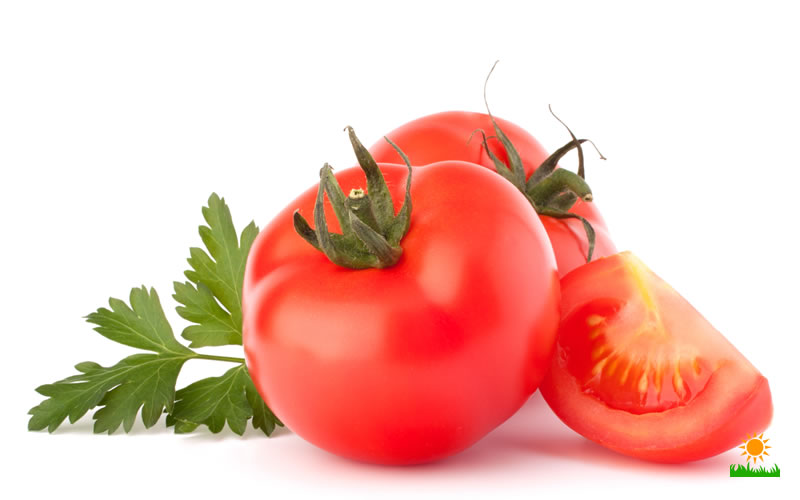
However, that is just a fraction of what tomatoes can do for you. Packed with essential vitamins and minerals, they are a treasure trove of greatness for the body. Especially organically grown ones right in your own back yard. Feeling lost? Don’t worry, we’re here to help.
Our Guide on the benefits of tomatoes and how to grow organic ones will teach you everything you need to know. We’ll explain all about the benefits and uses of tomatoes, breakdown the different varieties, share some tasty recipes and give you tips on how to grow your own (it’s easier than you think).
Tomatoes: The Big Picture
Tomatoes are one of the most common fruits you can find, yet they are anything but common-or ordinary. Naturally low in calories, they are loaded with vitamins and nutrients, making them so much more than a “diet” food.
They can provide you with a high percentage of your daily recommended doses and are a super food in terms of what they can do for your body. They are also quite versatile, as you can use them in salads, sandwiches, for juicing, to make tomato sauce, or for salsas and ketchup. Yes, you can make your own ketchup!
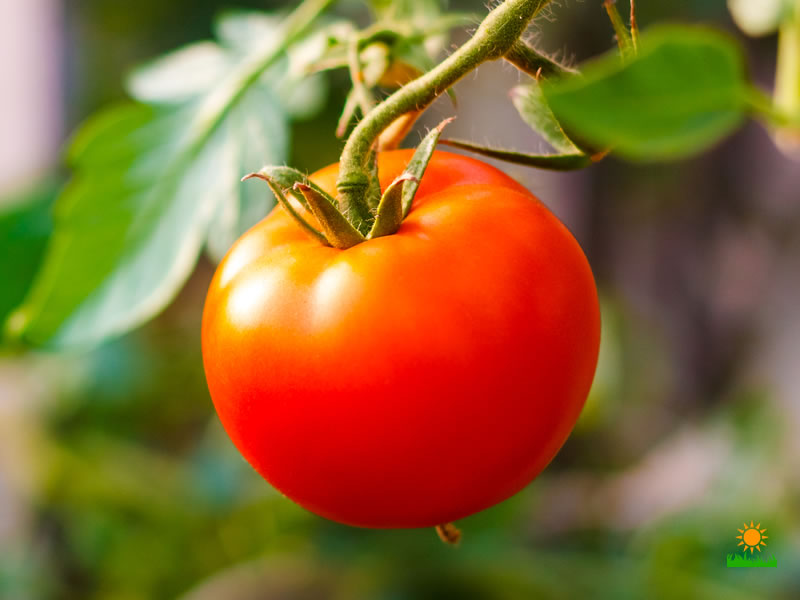
A cup of tomatoes, which is what you get in your average salad, contains 50% of the RDA (recommended daily allowance) for Vitamin C and 25% of the RDA for Vitamin A. And that’s just for starters. They also contain a substantial amount of iron, potassium, calcium, folic acid, Vitamin K and lycopene.
For those of you who don’t know, lycopene is an antioxidant that not only gives tomatoes their color, but also contains cancer fighting properties. And when you factor in the additional benefits of organically grown tomatoes, like increased vitamin and mineral content, it is easy to see why it is just as important to grow them as it is to include them in your daily det.
What Tomatoes Can Do For You
How exactly, do tomatoes help you? Let’s look at the numerous health benefits of eating them and find out:
[su_list icon=”icon: heart” icon_color=”#45bf55″]
- Low in fat and calories: At just 18 calories per 100 grams, they are low in calories as well as fat, with zero cholesterol. Which makes them great for your waistline and your heart.
[/su_list]
[su_list icon=”icon: heart” icon_color=”#45bf55″]
- Heart healthy: 0 cholesterol, plus high levels of potassium, niacin, folate and fiber make tomatoes great for your heart. Fiber is known to lower cholesterol and tomatoes have 9% of the recommended daily dose.
[/su_list]
Plus, they are rich in potassium, which has been proven to lower high blood pressure and fight heart disease. Finally, they lower homocysteine levels; homocysteine is a chemical in the body that cam damage your heart.
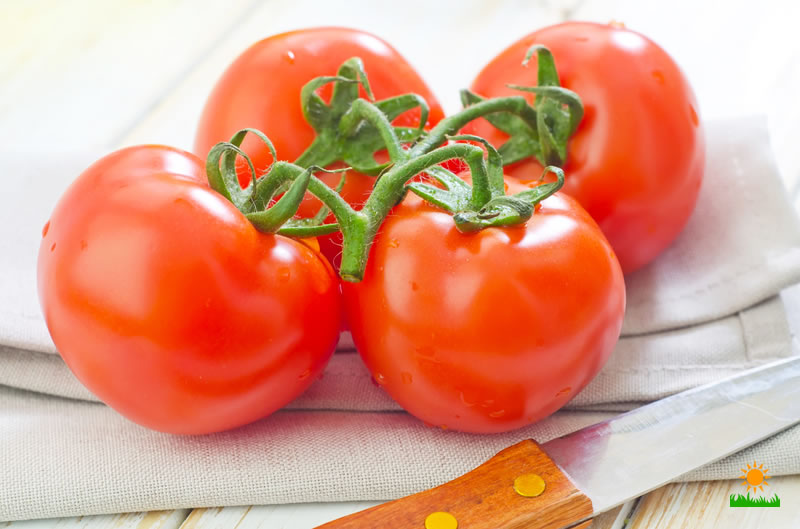
[su_list icon=”icon: heart” icon_color=”#45bf55″]
- Fight cancer: Lycopene, which is an anti-oxidant, can help fight different types of cancers and slows the growth of cancerous cells. Numerous studies show that eating tomatoes daily can reduce your risk for stomach, prostate and colorectal cancer.
[/su_list]
And here’s an added tip: cooked tomatoes yield higher amounts of lycopene, so whip up a Sunday sauce or brew a nice tomato soup.
[su_list icon=”icon: heart” icon_color=”#45bf55″]
- Great anti-inflammatory food: In addition to lycopene, tomatoes are full of beta carotene, Vitamins A and C, making them great for reducing inflammation by combatting free radicals. Free radicals can cause inflammation and cell degeneration, which is the cause of many debilitating diseases, including: atherosclerosis, asthma, and colon cancer.
[/su_list]
Just bear in mind that the cooking process destroys Vitamin C, so to reap these benefits you will want to eat uncooked tomatoes. Also, the redder the tomato, the higher it is in beta carotene.
[su_list icon=”icon: heart” icon_color=”#45bf55″]
- Good for your eyes: Besides beta carotene and lycopene, which are both good for your vision, tomatoes also contain lutein. Combined, these 3 elements protect your eyes from light-induced damage, which is a leading cause of cataracts, and macular degeneration brought on by age.
[/su_list]
[su_list icon=”icon: heart” icon_color=”#45bf55″]
- Improve bone density: Believe it or not, when it comes to building strong bones, tomatoes are just as effective as milk. Tomatoes are rich in Vitamin K, which has been proven to activate osteocalcin; osteocalcin anchors calcium deep within bone, making them stronger and less prone to becoming brittle with age.
[/su_list]
So you may want to pour a glass of tomato juice instead of milk for breakfast- just not with your cereal (unless that’s your thing).
The 5 Benefits of Eating Organic Tomatoes
Choosing The Right Tomato for You
There are many different varieties of tomato, and whether you eat them, grow them, or both, you need to know what to look for to choose the ones that best serve your needs.
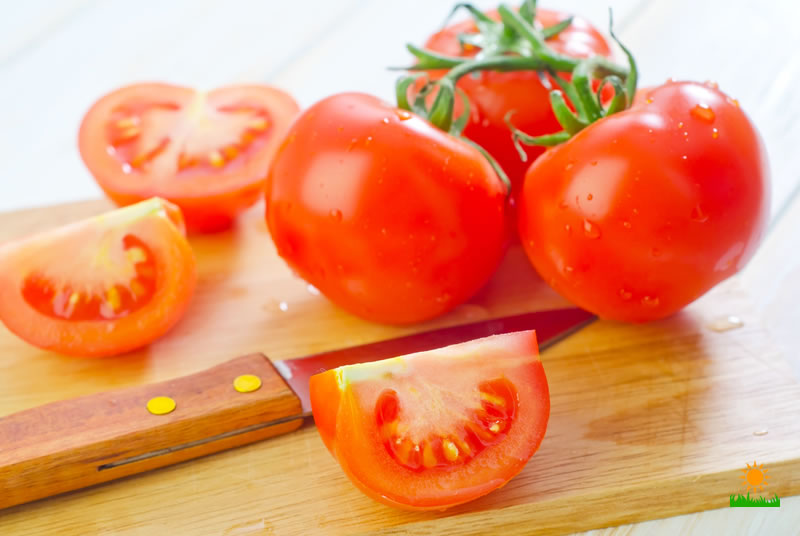
The 2 things that matter when it comes to tomatoes, and that you need to understand, are color and size. Here’s what you need to know:
Color
I’m sure the color red, or orange, is what pops in your head when I say tomato, but they actually come in a range of different colors- and it makes a difference.
Color tells you whether a tomato is acidic, sweet or somewhere in-between. Color and size can overlap, meaning some colors come in multiple sizes (like Red Cherry and Red Heirloom), so it helps to know the basics. Here is a rundown of the various colors and their meaning, along with a list of some of the types that are associated with them:
- Red/Pink: These are the most recognized and also the most complex types of tomatoes. They are the perfect balance of acidity and sweetness, to give you a burst of flavor with every bite. They work well for salads, canning and juicing.
Types: Brandywine, Big Beef, Stupice, Cherry, Vintage Wine, Red, Strawberry, Anna Russian.
- Yellow/Orange: Yellow and orange tomatoes are a bit more mellow and tend to have a sweeter taste. These tomatoes are great in salads and soups, especially when paired when a more acidic variety or other tart vegetable.
Types: Azoychka, Sungold, Orange Strawberry, Cherry, Yellow Brandywine, Mountain Gold, Taxi.
- Green: Green tomatoes, contrary to popular belief, are an actual variety and not just an unripe tomato (although unripe tomatoes are green). Distinguishable by a vertical stripe down the side, they are quite tart, but mellow when cooked, making them great for soups.
Types: Cherokee Gree, Green Zebra, German Green, Green Giant
- White: These tomatoes are mild, but sweet in flavor, and pair nicely with bolder varieties. They work best in salads.
Types: White Queen, White Wonder.
- Black/Purple/Brown: These darker varieties tend to be more acidic, and the darker the skin, the stronger the acidity.
Types: Black Krim, Cherokee Purple, Black Sea Man, Black Prince.
- Bi-Color: Distinguished by a yellow skin with red veining, these sweet offshoots of the yellow/orange variety make any salad fresh and balanced.
Types: Peppermint, Georgia Steak, Striped German.
Size
I hate to break it to you, but size matters when it comes to tomatoes. Seriously, size is important for planting and eating. For instance, larger varieties, like heirlooms, are great for canning and juicing, but if you’re growing them, you need the right amount of space. Here is a basic rundown of varieties by size:
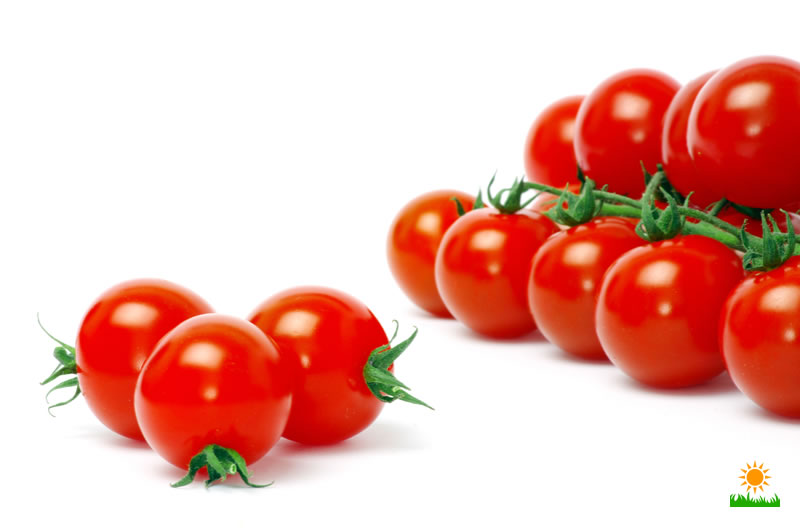
- Grape or Cherry: Small in size, they are perfect for beginning gardeners or those planting in pots. They come in a variety of colors and are great for salads, as a snack, or to get kids interested in healthy eating.
Sungold and Sweet 100 are in this category.
- Salad (Heirloom)Tomatoes: Salad, or heirloom tomatoes, are commonly used to make sauces or for juicing and are medium sized. They have a wide array of choices, as they are the most cultivated. One can use Vegetable Chopper to slice tomatoes and make your perfect yummy Veggie Salad.
Pantano Romanesco, Valencia, Green Zebra, Carmello and Stupice fall into this category.
- Beefsteak Tomatoes: These large, heavy, tomatoes are among the most popular, but require ample growing size and attention. They can grow up to 6” in size and take longer to grow, but are the ideal sandwich tomato.
Brandywine Pink, Cherokee Purple, and Big Beef are in this category.
Organic Vs Regular Tomatoes
If you’re wondering what the difference is between organic and regular grown tomatoes (and if it really matters) the answer is plenty. Regular grown tomatoes are sprayed with pesticides, affecting the look and taste of them.
They also are less nutritious, as they are altered by the chemicals in the pesticides, which cause a reaction and lessen the potency of the vitamins they contain.
While both are safe to consume, organic tomatoes are all natural and packed with more minerals and vitamins. They are grown in soil that is not treated and are not sprayed with any chemicals, so their natural colors and flavors come through.
How to Grow Organic Tomatoes in Scale
The idea of growing your own organic tomatoes may seem daunting, but in reality it is not that difficult. Now that you know about the different varieties, you just need to know the basics to get your organic garden going.
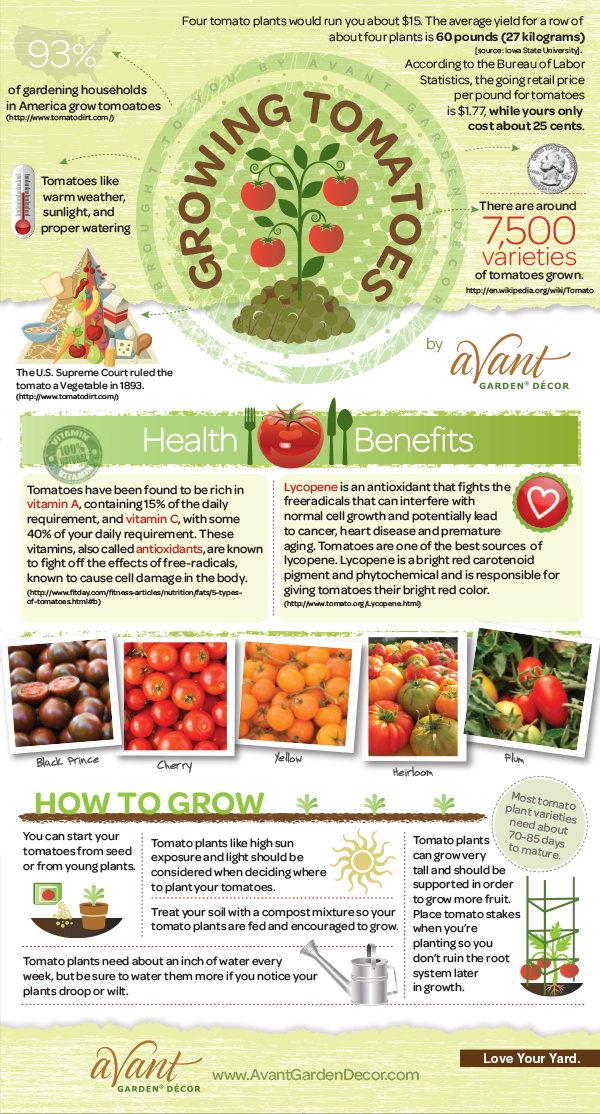
Shared via Avant Garden Decor
Pick and Prepare the Space
Whether you are growing outside in a large garden or in individual containers/pots, you must properly pick and prepare the area.
This starts by picking a spot that gets a minimum of 5 hours of sunlight a day, as tomatoes need lots of sunlight to grow. Watch your yard, porch or windowsills to see patterns and find the right place.
Once you find the ideal area, cultivate the dirt. To do this, work the soil, adding compost or manure. You should also add a quarter cup of eggshells, as tomatoes are ravenous plants.
For those with large gardens, consider crop rotation and do not tomatoes and similar plants, like eggplants, potatoes or peppers, in the same area 2 years in a row.
Choose the Type of Tomatoes You Want to Grow
In addition to size, you need to know what tomatoes grow in your area to get the best results. For instance, if you live in an area like Alaska, which has more cold than warm months, you want a variety that blossoms quickly, like cherry tomatoes.
You also want to pick the kind you want to use: beefsteaks are perfect for those who love to juice or make canned sauces.
However, they take about 90 days to bloom, so if you live in the Northeast you want to plant them right after the first frost. For planters, 4th of July’s are a good choice, yielding a large amount of tomatoes.
You can plant seeds or a plant, the choice is yours and makes no difference in terms of production.
Plant and Grow
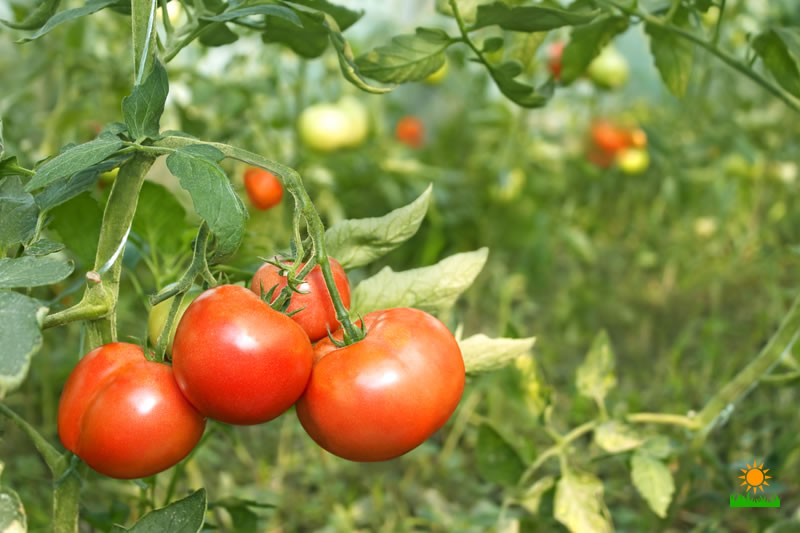
Whether it’s seeds or a young plant, once the frost risk has passed you can plant. Dig a hole, at least 6” deep and lay the seeds or remove the seedling plant from its pot and lay it in so only 3-4” show above ground. With tomatoes, the deeper the better.
For container or pot planting, follow the same rules, using a deep pot.
- Decide if you want to add supports: Tomato plants can grow along the ground, or you can build a trellis or cage to have them grow up. If you trellis, it increases light exposure and keeps pests away, but can make harvesting a bit of a hassle.
As an alternative, you can use wooden stakes if you want support without a hassle.
- Water properly: On average tomato plants need about an inch of rainwater a week. Too much or too little can cause rot, so pay attention.
- Mulching and weeding: Mulching is up to you: if you want to keep plants warm or deter weeds (not all of them), mulching is a good option. You can use wet newspaper and straw (my favorite), and if you want extra heat add landscape fabric over it.
If you don’t mulch you can do some light hoeing to remove weeds, but don’t go too deep. During Winter, don’t forget to clean out your gardening area with a snow blower and other snow gear.
Last, but not least, pick and enjoy!
Tomato Recipes
Tomatoes can be used in a variety of ways, improving your diet and health. Here are some great recipes to get you started:
Tomato Salsa
Ingredients
[su_list icon=”icon: heart” icon_color=”#45bf55″]
- 2-3 medium sized fresh tomatoes (1-1 ½ lb), stems removed
- 1/2 red onion
- 2 serrano chiles or 1 jalapeño chile (remove stems and seeds)
- Lime juice (one lime)
- 1/2 cup chopped cilantro
- Salt and pepper to taste
- Pinch of dried oregano
[/su_list]
Prep: Rough chop the tomatoes, chile and onion, leaving the chile seeds on the side if you want to make it spicier.
Then, add all the ingredients to a food processor and pulse to dice, don’t pure. Transfer to a bowl and add salt, pepper and oregano to taste. Add chile seeds if desired. Chill for an hour.
Tomato Vegetable Juice
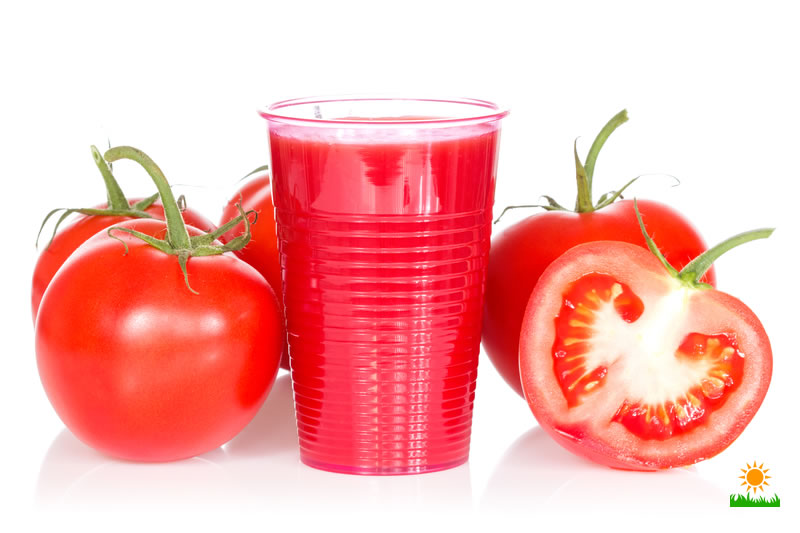
Ingredients
[su_list icon=”icon: heart” icon_color=”#45bf55″]
- 2 large tomatoes (like beefsteak) cut in wedges
- 1 cup hearts of romaine, chopped
- 1/4 cup fresh chives, chopped
- 1 large red bell pepper, sliced into eights
- ¼ of a jalapeno, seeds removed.
- 2 large stalks of celery
- 1 medium carrot, cut and peeled
- Ice cubes (optional)
[/su_list]
Prep: Using a juicer, put the ingredient intot the machine in this order: lettuce, chives, tomatoes, jalapeno, bell pepper, celery and carrot. Add ice cubes and enjoy.
If you don’t have a juicer you can put all the ingredients in a blender, liquefy, then pass them through a stack of 4 cheesecloths.
As you can see from our Guide on the benefits of tomatoes and how to grow organic ones, tomatoes are a must in any home, providing essential nutrients and bursting with flavor. They make you healthier and stronger inside and out, fighting disease and giving you healthy skin and bones. See other veggies you can grow at home here too.
With the ability to make them into sauces, juices, salsas and more, they are easy to incorporate into your daily diet and are a super food the whole family can enjoy. Plus, you can grow your own, getting the whole family involved and making fresh, organic tomatoes everyone will love.
